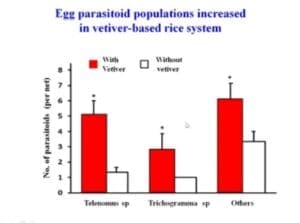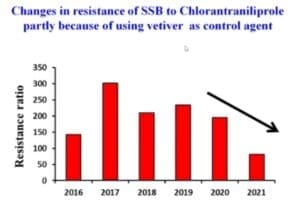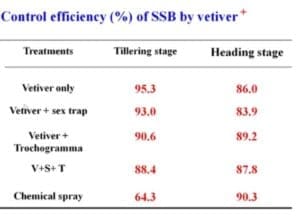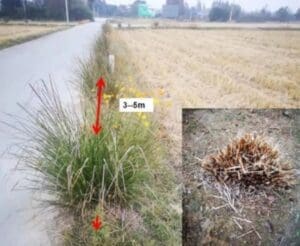 On March 1, 2022 TVNI hosted a webinar (#5): Vetiver Grass for the Control of Stem Borer of Rice in China. The Guest speaker, Dr. Zhongxian Lu, professor and head of crop insect pest management at the Institute of Plant Protection and Microbiology, Zhejiang Academy of Agricultural Sciences, Hangzhou, China. He gave an excellent presentation of the science that backs the use of vetiver grass as the key component of an eco-engineering technology that has thus far transformed the control of striped and pink stem borer in 270,000 ha of rice in 14 provinces of southern China. This has resulted in a 70 – 80% reduction in pesticide use, and improved farm income through cost reductions of insecticide application, quality improvement of rice, and additional income from the sale of sesame seed. The webinar video can be found at: https://youtu.be/gIYUMypvl48 . The tables and figures contain a wealth of information that should be carefully studied.
On March 1, 2022 TVNI hosted a webinar (#5): Vetiver Grass for the Control of Stem Borer of Rice in China. The Guest speaker, Dr. Zhongxian Lu, professor and head of crop insect pest management at the Institute of Plant Protection and Microbiology, Zhejiang Academy of Agricultural Sciences, Hangzhou, China. He gave an excellent presentation of the science that backs the use of vetiver grass as the key component of an eco-engineering technology that has thus far transformed the control of striped and pink stem borer in 270,000 ha of rice in 14 provinces of southern China. This has resulted in a 70 – 80% reduction in pesticide use, and improved farm income through cost reductions of insecticide application, quality improvement of rice, and additional income from the sale of sesame seed. The webinar video can be found at: https://youtu.be/gIYUMypvl48 . The tables and figures contain a wealth of information that should be carefully studied.
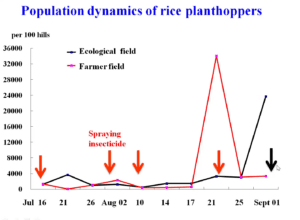
Dr Xhongxian Lu and his team were part of a regional team that initially studied (over four years in China, Vietnam and Thailand) the role of eco-diversity of nectar producing plants, such as sesame, that would attract and enhance parasitoidal insects that could reduce rice planthopper populations. The studies, multi-country evidence that crop diversification promotes ecological intensification of agriculture (researchgate.net), showed that as a result of eco-diversification there was a 70% reduction in pesticide applications, 5% increased grain yield, and an overall economic advantage of 7.5%.
In 2003, Johnnie Van Den Berg of South Africa showed the potential of vetiver as a dead-end trap crop for controlling Chilo partellus, stem borer of maize and sorghum – see SA_stem borer.pdf (vetiver.org) Field trials in a number of eastern and central African countries have confirmed this. At that time Van Den Berg wrote of the possibility of vetiver controlling stem borer in rice.
Subsequently, as a result of China’s environmental policy of reducing the use of agricultural chemicals without loss of economic benefits to farmers, Dr Lu and his team studied the possibility of including vetiver grass (Chrysopogon zizanioides) as component to an eco-engineering approach to control the other major pests of rice the striped and pink stem borers. This work was published in a paper “Rice Pest Management by Ecological Engineering: A Pioneering Attempt in China” (2015).
Dr. Lu’s webinar presentation set out the science, the application and results of this technology. Truly an exciting and compelling story. Some of the key points of his presentation are set out below:
- Vetiver grass was the critical component to the success of reducing stem borer damage in rice using an eco-engineering approach.
- Scientific studies were carried out on important contributing factors including the effectiveness of vetiver as a dead-end trap crop; vetiver chemical studies to determine the most attractive vetiver pheromones to the male and female moths; the determinants in vetiver that ultimately destroyed the larva; the identification of insecticidal chemicals in vetiver, and the spatial requirements and annual management practices of vetiver in relation to the rice crop.
- Vetiver proved to be excellent habitat for parasitoid insects, the latter further reduced incidence of stemborer and rice planthopper populations.
- Some key points of interest:
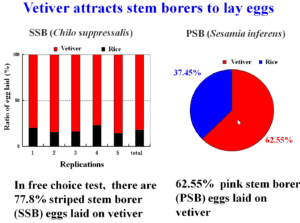 Stem borer has a significant preference for vetiver grass over rice for egg laying (78% for striped stem borer and 63% for pink stem borer). Vetiver contains an estimated 250 different chemical compounds, some 20 of these resulted in pheromones that attracted stem borer. These pheromones had different levels of attraction, and were significantly more powerful when 10g of N fertilizer was applied to each clump of vetiver. Male and female moths were attracted by different pheromones.
Stem borer has a significant preference for vetiver grass over rice for egg laying (78% for striped stem borer and 63% for pink stem borer). Vetiver contains an estimated 250 different chemical compounds, some 20 of these resulted in pheromones that attracted stem borer. These pheromones had different levels of attraction, and were significantly more powerful when 10g of N fertilizer was applied to each clump of vetiver. Male and female moths were attracted by different pheromones.
Stem borer cannot complete its lifecycle in vetiver. The larva do not survive past the 4th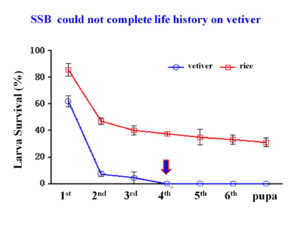 instar stage. This is due to a number of contributing factors. Total sugars, cellulose, and protein are much lower in vetiver than in rice, and the level of toxins, especially tannin, are much higher in vetiver. The combination impacts the digestive enzymes of the stem borer larva, leading to death. The effectiveness
instar stage. This is due to a number of contributing factors. Total sugars, cellulose, and protein are much lower in vetiver than in rice, and the level of toxins, especially tannin, are much higher in vetiver. The combination impacts the digestive enzymes of the stem borer larva, leading to death. The effectiveness 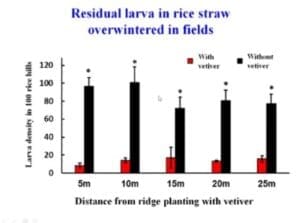 of vetiver in controlling stem borer also results in a significant reduction of over wintering of stem borer.
of vetiver in controlling stem borer also results in a significant reduction of over wintering of stem borer.
Some other important observations are shown in the following figures:
